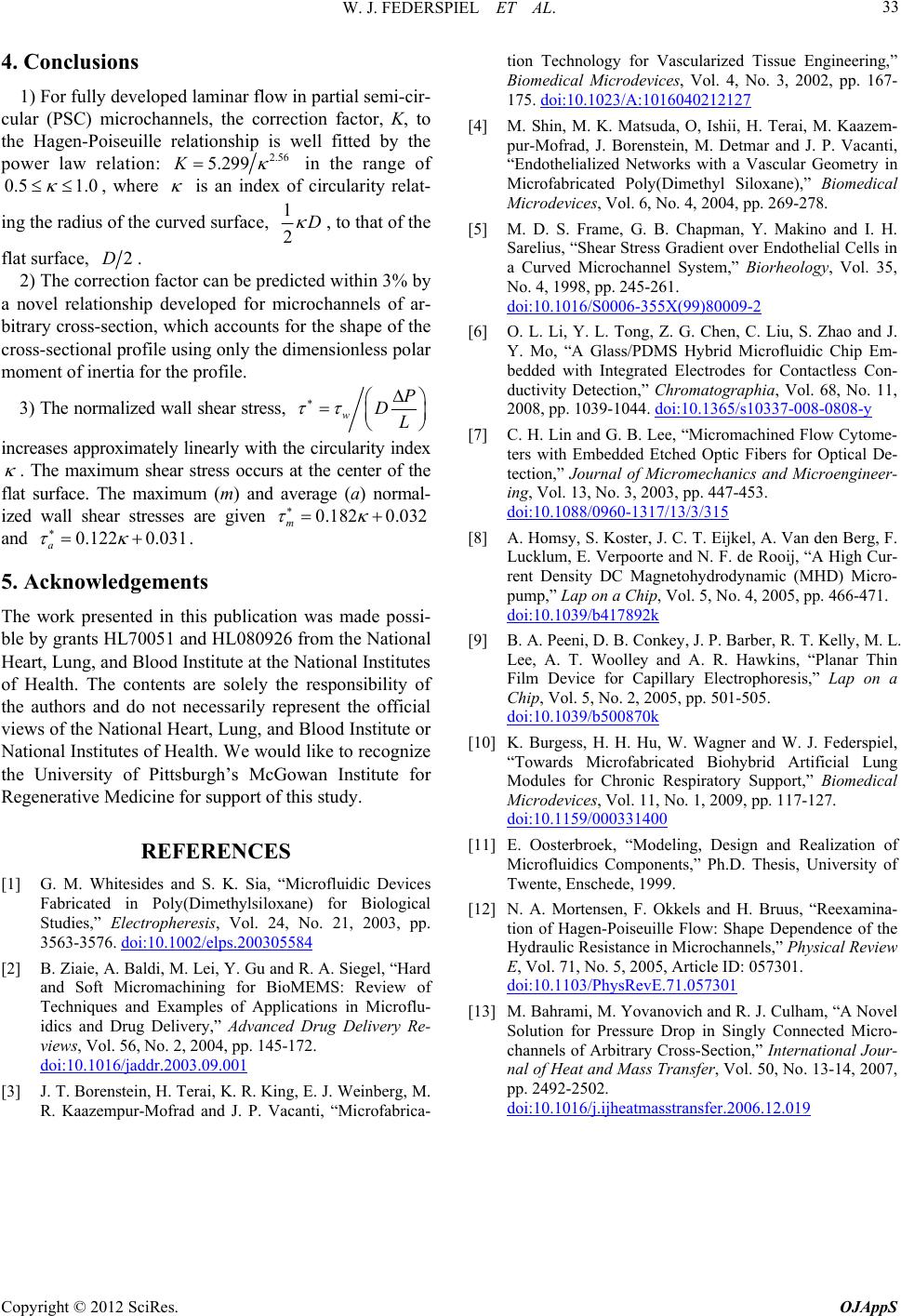
W. J. FEDERSPIEL ET AL.
Copyright © 2012 SciRes. OJAppS
33
4. Conclusions
1) For fully developed laminar flow in partial semi-cir-
cular (PSC) microchannels, the correction factor, K, to
the Hagen-Poiseuille relationship is well fitted by the
power law relation: 2.56
5.299K
in the range of
, where is an index of circularity relat-
0.5 1.0
ing the radius of the curved surface, 1
2D
, to that of the
flat surface, 2D.
2) The correction factor can be predicted within 3% by
a novel relationship developed for microchannels of ar-
bitrary cross-section, which accounts for the shape of the
cross-sectional profile using only the dimensionless polar
moment of inertia for the profile.
3) The normalized wall shear stress, wP
DL
increases approximately linearly with the circularity index
. The maximum shear stress occurs at the center of the
flat surface. The maximum (m) and average (a) normal-
ized wall shear stresses are given
and .
0.1820.032
m
0.122 0.031
a
5. Acknowledgements
The work presented in this publication was made possi-
ble by grants HL70051 and HL080926 from the National
Heart, Lung, and Blood Institute at the National Institutes
of Health. The contents are solely the responsibility of
the authors and do not necessarily represent the official
views of the National Heart, Lung, and Blood Institute or
National Institutes of Health. We would like to recognize
the University of Pittsburgh’s McGowan Institute for
Regenerative Medicine for support of this study.
REFERENCES
[1] G. M. Whitesides and S. K. Sia, “Microfluidic Devices
Fabricated in Poly(Dimethylsiloxane) for Biological
Studies,” Electropheresis, Vol. 24, No. 21, 2003, pp.
3563-3576. doi:10.1002/elps.200305584
[2] B. Ziaie, A. Baldi, M. Lei, Y. Gu and R. A. Siegel, “Hard
and Soft Micromachining for BioMEMS: Review of
Techniques and Examples of Applications in Microflu-
idics and Drug Delivery,” Advanced Drug Delivery Re-
views, Vol. 56, No. 2, 2004, pp. 145-172.
doi:10.1016/jaddr.2003.09.001
[3] J. T. Borenstein, H. Terai, K. R. King, E. J. Weinberg, M.
R. Kaazempur-Mofrad and J. P. Vacanti, “Microfabrica-
tion Technology for Vascularized Tissue Engineering,”
Biomedical Microdevices, Vol. 4, No. 3, 2002, pp. 167-
175. doi:10.1023/A:1016040212127
[4] M. Shin, M. K. Matsuda, O, Ishii, H. Terai, M. Kaazem-
pur-Mofrad, J. Borenstein, M. Detmar and J. P. Vacanti,
“Endothelialized Networks with a Vascular Geometry in
Microfabricated Poly(Dimethyl Siloxane),” Biomedical
Microdevices, Vol. 6, No. 4, 2004, pp. 269-278.
[5] M. D. S. Frame, G. B. Chapman, Y. Makino and I. H.
Sarelius, “Shear Stress Gradient over Endothelial Cells in
a Curved Microchannel System,” Biorheology, Vol. 35,
No. 4, 1998, pp. 245-261.
doi:10.1016/S0006-355X(99)80009-2
[6] O. L. Li, Y. L. Tong, Z. G. Chen, C. Liu, S. Zhao and J.
Y. Mo, “A Glass/PDMS Hybrid Microfluidic Chip Em-
bedded with Integrated Electrodes for Contactless Con-
ductivity Detection,” Chromatographia, Vol. 68, No. 11,
2008, pp. 1039-1044. doi:10.1365/s10337-008-0808-y
[7] C. H. Lin and G. B. Lee, “Micromachined Flow Cytome-
ters with Embedded Etched Optic Fibers for Optical De-
tection,” Journal of Micromechanics and Microengineer-
ing, Vol. 13, No. 3, 2003, pp. 447-453.
doi:10.1088/0960-1317/13/3/315
[8] A. Homsy, S. Koster, J. C. T. Eijkel, A. Van den Berg, F.
Lucklum, E. Verpoorte and N. F. de Rooij, “A High Cur-
rent Density DC Magnetohydrodynamic (MHD) Micro-
pump,” Lap on a Chip, Vol. 5, No. 4, 2005, pp. 466-471.
doi:10.1039/b417892k
[9] B. A. Peeni, D. B. Conkey, J. P. Barber, R. T. Kelly, M. L.
Lee, A. T. Woolley and A. R. Hawkins, “Planar Thin
Film Device for Capillary Electrophoresis,” Lap on a
Chip, Vol. 5, No. 2, 2005, pp. 501-505.
doi:10.1039/b500870k
[10] K. Burgess, H. H. Hu, W. Wagner and W. J. Federspiel,
“Towards Microfabricated Biohybrid Artificial Lung
Modules for Chronic Respiratory Support,” Biomedical
Microdevices, Vol. 11, No. 1, 2009, pp. 117-127.
doi:10.1159/000331400
[11] E. Oosterbroek, “Modeling, Design and Realization of
Microfluidics Components,” Ph.D. Thesis, University of
Twente, Enschede, 1999.
[12] N. A. Mortensen, F. Okkels and H. Bruus, “Reexamina-
tion of Hagen-Poiseuille Flow: Shape Dependence of the
Hydraulic Resistance in Microchannels,” Physical Review
E, Vol. 71, No. 5, 2005, Article ID: 057301.
doi:10.1103/PhysRevE.71.057301
[13] M. Bahrami, M. Yovanovich and R. J. Culham, “A Novel
Solution for Pressure Drop in Singly Connected Micro-
channels of Arbitrary Cross-Section,” International Jour-
nal of Heat and Mass Transfer, Vol. 50, No. 13-14, 2007,
pp. 2492-2502.
doi:10.1016/j.ijheatmasstransfer.2006.12.019